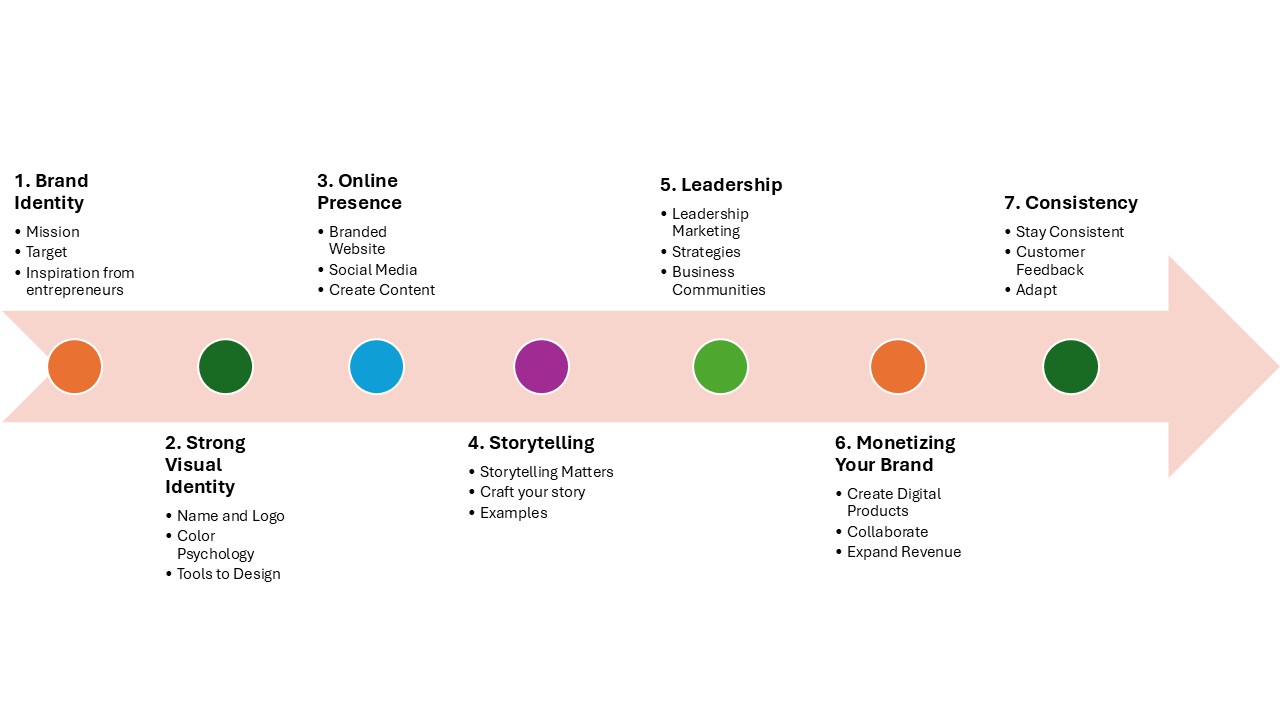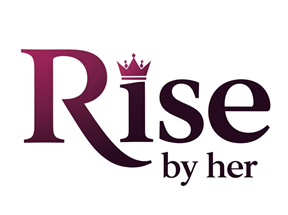In today’s competitive market, personal branding for women is more than just a buzzword—it’s a strategic necessity. A powerful brand helps you stand out, build trust with your audience, and create long-term business success. Whether you’re launching a startup or scaling an existing business, a strong brand strategy for entrepreneurs can be the difference between blending in and becoming an industry leader.
However, women entrepreneurs often face unique branding challenges, from overcoming industry biases to balancing authenticity with professionalism. Many struggles with defining their brand identity, crafting a compelling brand story, or maintaining consistency across digital platforms.
In this guide, we’ll explore essential branding strategies tailored for women entrepreneurs in 2025. From building a unique value proposition to leveraging social media and PR, you’ll learn how to create a brand that resonates, attracts loyal customers, and drives business growth. Let’s dive in!

1. Defining Your Brand Identity & Unique Value Proposition
A successful business starts with a clear brand identity, how your audience perceives you and what makes your brand unique. To stand out in a competitive market, you need a well-defined unique selling proposition (USP) and strategic brand positioning that aligns with your mission and values.

Clarify Your Mission, Values, and Niche
Your brand should reflect what you stand for. Ask yourself:
- What problem does my business solve?
- What values drive my brand?
- How do I want customers to feel when they interact with my brand?
A strong mission builds trust and loyalty, while a well-defined niche helps position your brand as an expert in your industry.
Identify Your Target Audience & Brand Voice
Your brand positioning should resonate with the right audience. Define:
- Who they are (demographics, interests, pain points).
- How they communicate (formal vs. casual, emotional vs. logical messaging).
- What they expect from your brand.
Your brand voice—whether authoritative, friendly, or empowering—should remain consistent across all platforms to create a memorable experience.
Learn from Women Entrepreneurs with Strong Branding
Successful women entrepreneurs understand the power of branding. Examples include:
- Sara Blakely (SPANX) – A bold, empowering voice targeting women in business.
- Sophia Amoruso (Girlboss) – A niche personal brand that blends authenticity with business expertise.
- Rihanna (Fenty Beauty) – A brand that disrupted the beauty industry by addressing inclusivity.
By crafting a clear brand identity and strong USP, you can position your business for long-term success and recognition.
2. Crafting a Memorable Brand Name, Logo, and Visual Identity
A powerful brand begins with a strong visual identity, and that starts with your name, logo, and design elements. These are the first things people notice, and they play a major role in how your brand is perceived. Thoughtful brand design helps you build recognition, trust, and emotional connection with your audience.

Choosing the Right Brand Name and Logo
Your brand name should be:
- Simple and easy to remember
- Relevant to your niche or values
- Unique enough to stand out and avoid legal issues
Your logo design for business should be adaptable, recognizable at any size, and aligned with your overall tone (e.g., modern, elegant, bold). A good logo reflects your brand personality and reinforces your identity across all platforms.
Color Psychology and Typography in Branding
Colors and fonts are more than aesthetics, they influence perception and behavior.
- Color psychology: Blue signals trust, red evokes passion, green suggests health or eco-consciousness.
- Typography: Serif fonts feel traditional; sans-serif fonts feel modern. Script fonts can feel personal or creative.
Consistence in your visual branding helps create a professional and unified look across your website, packaging, and marketing materials.
Tools to Design Your Brand
- Canva: Easy-to-use platform for designing logos, social media graphics, and brand kits.
- Adobe Express: Great for more advanced branding and design customization.
- Tailor Brands: AI-powered tool that generates logos and brand assets based on your preferences.
Investing in quality visual branding sets the tone for your business and builds a strong foundation for future growth.
3. Building a Strong Online Presence: Website & Social Media
In 2025, your digital presence is often the first impression potential customers get. For women entrepreneurs, having a professional, consistent online presence can be the key to building trust, attracting clients, and standing out in a competitive market.

The Power of a Branded Website
Your website is your digital headquarters. It should reflect your brand identity, communicate your value, and guide visitors to act. Focus on:
- User-friendly design: Clear navigation, mobile optimization, fast load times.
- SEO best practices: Keyword-rich content, optimized images, meta descriptions.
- Strong branding: Consistent fonts, colors, tone, and messaging throughout.
Platforms like WordPress, Wix, and Shopify make it easier than ever to create a branded, functional site without coding skills.
Social Media for Women Entrepreneurs
Social platforms are powerful tools for visibility and engagement. Use Instagram, LinkedIn, and TikTok strategically to showcase your expertise and humanize your brand:
- Instagram: Visual storytelling, behind-the-scenes, and product showcases.
- LinkedIn: Thought leadership, networking, and credibility building.
- TikTok: Creative, authentic content that can boost reach and relatability.
Consistency across platforms builds brand recognition and makes your business more memorable.
Create Content That Builds Trust
Content is where your voice comes to life. Share valuable insights, answer common questions, and highlight your journey. Content types to consider:
- Educational blog posts and videos
- Client success stories
- Live Q&As and behind-the-scenes snippets
Authenticity builds authority. When your audience sees the real person behind the brand, they’re more likely to trust and buy from you.
A strong website branding strategy and active social media presence can transform you from just another business into a go-to expert in your niche.
4. Storytelling: Creating an Authentic and Relatable Brand Story
In today’s saturated market, facts and features alone don’t sell — stories do. For women entrepreneurs, brand storytelling is a powerful tool to build emotional connections, humanize your brand, and inspire trust.
Why Storytelling Matters in Branding
Your audience wants more than just one product, they want to know the why behind your business. A well-told personal brand story:
- Make your brand more memorable
- Builds emotional branding that connects on a deeper level
- Helps you stand out by highlighting your unique path and purpose
How to Craft Your Brand Story
Start with your journey. Think about:
- What inspired you to start your business?
- What challenges did you overcome?
- What values drive your mission?
Be authentic and vulnerable, your struggles and growth are often what make your story relatable and inspiring.
Use your story consistently across your website, social media bios, About pages, and marketing content to reinforce your brand’s identity.
Examples of Powerful Storytelling
- Whitney Wolfe Herd (Bumble) shares her journey from leaving a toxic work environment to building a female-first social network.
- Sophia Amoruso (Girlboss) uses raw, honest storytelling to connect with her audience and build a movement.
By tapping into emotional branding, you’re not just selling — you’re creating loyal followers who believe in your mission and message.
5. Leveraging Thought Leadership & PR for Brand Authority
Establishing yourself as a thought leader is one of the most powerful ways to build brand authority as a woman entrepreneur. It positions you as the go-to expert in your field, increases trust, and opens doors to new growth opportunities.
What Is Thought Leadership Marketing?
Thought leadership marketing is about sharing your insights, ideas, and expertise to influence others in your industry. When done well, it builds credibility, attracts media attention, and strengthens your brand’s voice.
Strategies to Build Authority
- Write guest blog posts on reputable websites and platforms in your niche.
- Speak at industry events, webinars, and podcasts, your voice matters.
- Pitch your story to media outlets and local press using PR tools like HARO (Help a Reporter Out) or Qwoted.
Leverage LinkedIn and Business Communities
Use LinkedIn to publish thought pieces, engage in professional conversations, and network with peers. Join women-focused communities like Ellevate Network or Women Who Startup to collaborate and grow your presence.
By combining PR strategies for entrepreneurs with authentic thought leadership, you elevate not only your business, but your influence.
6. Monetizing Your Brand: Turning Influence into Income
Once you’ve built a strong, trusted brand, it’s time to turn that influence into real revenue. Brand monetization is about strategically using your visibility and authority to create sustainable income streams—beyond just selling products or services.
Create Digital Products & Premium Services
Use your expertise to develop online courses, ebooks, coaching programs, or memberships. These offerings let you scale your brand while delivering value to your audience.
Partner with Brands & Collaborate
If you’ve built a loyal following, brand partnerships and sponsorships can be a great income source. Reach out to businesses aligned with your values for paid collaborations or ambassador opportunities.
Expand Revenue with Intentional Branding
A strong personal brand can open doors to speaking engagements, affiliate marketing, consulting, or launching your own product line. It’s about branding for business growth, not just visibility.
By aligning your passion with smart strategy, your brand becomes more than just a name, it becomes a business engine.
7. Consistency & Long-Term Brand Growth Strategies
Building a powerful brand doesn’t stop after launch—it’s about maintaining brand consistency and evolving with purpose. Long-term business growth strategies rely on staying recognizable, reliable, and relevant.
Stay Consistent Across All Channels
Whether it’s your website, Instagram bio, LinkedIn posts, or email newsletters—your tone, visuals, and messaging should reflect a unified brand identity. This builds trust and makes your brand instantly recognizable.
Use Customer Feedback to Evolve
Your audience is your best resource. Listen to reviews, DMs, and engagement patterns to improve and refine your brand. It helps you stay aligned with what your audience values.
Adapt, Don’t Drift
Trends come and go, but your core values shouldn’t. Adapt your strategy—try new platforms, refresh your look—but always stay rooted in your brand’s mission. That’s how you grow with integrity.
Consistency fuels credibility, and credibility drives long-term success.
Conclusion: Take Action & Build Your Powerful Brand
Building a strong, recognizable brand isn’t just about logos and color schemes—it’s about telling your story, owning your space, and showing up consistently. For women entrepreneurs, branding is one of the most powerful tools for standing out and scaling up.
From defining your brand identity to leveraging thought leadership and monetizing your influence, these successful branding strategies are your foundation for long-term growth.
Now it’s your turn—start refining your brand today and watch the impact it has on your business journey.
What’s your biggest branding challenge? Share in the comments, we’d love to hear your story!


